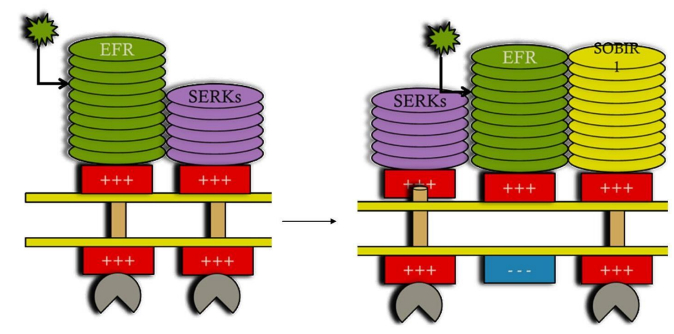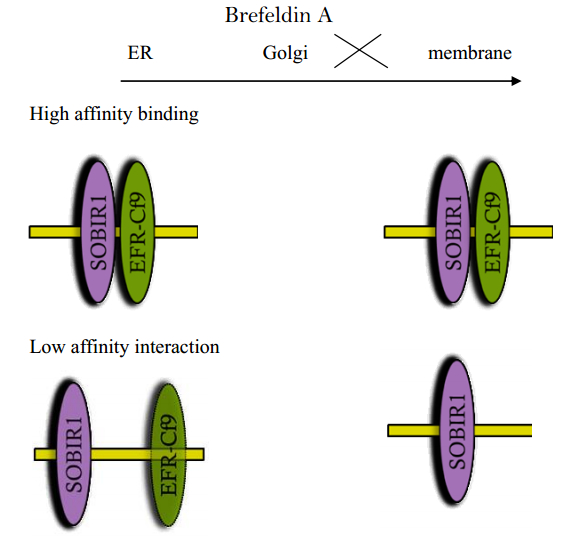Plants activate an immune response in defense against microbial pathogens. The first layer of immunity consists in the recognition of microbial fingerprints, called Pathogen Associated Molecular Pattern (PAMP), by a set of Pattern Recognition Receptors (PRR). In addition, the degradation products from fungi, bacteria and plant cells are recognised as Damage Associated Molecular Pattern (DAMP).
The first layer of plant defence is based on Pattern Recognition Receptors (PRR) on the membrane. These receptors, either receptor kinases or receptor-like proteins (RLPs), associating with cytoplasmic kinases, recognize the presence of PAMPs, thus activating a local response named PAMP-triggered immunity (PTI), that is not strong but effective towards many pathogen species. Here we discuss and focus on Elongation Factor Tu Receptors (EFR) and flagellin sensing (FLS) receptors. In leucine-rich repeat (LRR) receptor proteins, the hydrophobic LLR domains are exposed on external membranes, providing the protein-protein interaction modules. Plants evolved this protein-protein interaction domain several times during the development of mechanisms to defend themselves from viruses, virulence factors, enzymes and effectors of bacterial and fungal pathogens.
Pathogens in addition evolved proteins and enzymes that are injected in the plant cell to counterfight plant immune signaling pathways. These effectors are recognised by plant receptors sensing their presence of their cognate avirulence genes. These receptors originated from recombination during evolution and only occur in some specific tomato genotypes, instead of the widely occurring PPRs. Effector Triggered Immunity (ETI) allows a plant response to effector proteins that is more strong, but is race specific. It leads to local necrosis and apoptosis, and to the establishment of the hypersensitive response (HR). For biotrophic or hemibiotrophic pathogens, necrosis is an effective way to limit their spread, while for necrotrophic pathogens this is not efficient and sufficient way to limit their spread, since depends on the timing of infection and on the plant development phase. Pathogenic fungi strategy relies on the formation of specialised structures, or haustoria, that facilitate the nutrient uptake form plant cells. In this review, we summarize the most recent knowledge on plant pathogens and the mechanisms they evolved to circumvent plant defences among which pathogen effectors, protein decoys inactivating plant defence signals. Effectors are recognised through their binding to plant proteins by means of plant receptors, that activate the Effector Triggered Immunity (ETI). In particular, we focus on the Solanaceae, discussing general mechanisms and specific pathways that confer resistance to various pathogens.
There is an arm race between plants and fungal and bacterial pathogens that has led to new protein variants and protein decoys (pseudokinases, inhibitors and sponges blocking glucanases, and Transcription Activator Like Effectors). Advances in understanding the function of pathogen effectors will provide new ways to improve plant immunity and mechanisms of defence against their pests. Finally, we present possible combinations of interventions, from gene engineering to chemical priming, acting on signaling pathways regulated by jasmonate and salicylate hormones, to increase plant resistance and activate plant defences without affecting crop yields.
1.
Introduction
Recently, fractional calculus methods became of great interest, because it is a powerful tool for calculating the derivation of multiples systems. These methods study real world phenomena in many areas of natural sciences including biomedical, radiography, biology, chemistry, and physics [1,2,3,4,5,6,7]. Abundant publications focus on the Caputo fractional derivative (CFD) and the Caputo-Hadamard derivative. Additionally, other generalization of the previous derivatives, such as Ψ-Caputo, study the existence of solutions to some FDEs (see [8,9,10,11,12,13,14]).
In general, an m-point fractional boundary problem involves a fractional differential equation with fractional boundary conditions that are specified at m different points on the boundary of a domain. The fractional derivative is defined using the Riemann-Liouville fractional derivative or the Caputo fractional derivative. Solving these types of problems can be challenging due to the non-local nature of fractional derivatives. However, there are various numerical and analytical methods available for solving such problems, including the spectral method, the finite difference method, the finite element method, and the homotopy analysis method. The applications of m-point fractional boundary problems can be found in various fields, including physics, engineering, finance, and biology. These problems are useful in modeling and analyzing phenomena that exhibit non-local behavior or involve memory effects (see [15,16,17,18]).
Pantograph equations are a set of differential equations that describe the motion of a pantograph, which is a mechanism used for copying and scaling drawings or diagrams. The equations are based on the assumption that the pantograph arms are rigid and do not deform during operation, we can simply say that see [19]. One important application of the pantograph equations is in the field of drafting and technical drawing. Before the advent of computer-aided design (CAD) software, pantographs were commonly used to produce scaled copies of drawings and diagrams. By adjusting the lengths of the arms and the position of the stylus, a pantograph can produce copies that are larger or smaller than the original [20], electrodynamics [21] and electrical pantograph of locomotive [22].
Many authors studied a huge number of positive solutions for nonlinear fractional BVP using fixed point theorems (FPTs) such as SFPT, Leggett-Williams and Guo-Krasnosel'skii (see [23,24]). Some studies addressed the sign-changing of solution of BVPs [25,26,27,28,29].
In this work, we use Schauder's fixed point theorem (SFPT) to solve the semipostone multipoint Ψ-Caputo fractional pantograph problem
where λ∈(0,ℑ−rℑ),Dν;ψr is Ψ-Caputo fractional derivative (Ψ-CFD) of order ν, 1<ν≤2, ζi∈R+(1≤i≤m−2) such that 0<Σm−2i=1ζi<1, ηi∈(r,ℑ), and F:[r,ℑ]×R×R→R.
The most important aspect of this research is to prove the existence of a positive solution of the above m-point FBVP. Note that in [30], the author considered a two-point BVP using Liouville-Caputo derivative.
The article is organized as follows. In the next section, we provide some basic definitions and arguments pertinent to fractional calculus (FC). Section 3 is devoted to proving the the main result and an illustrative example is given in Section 4.
2.
Preliminaries
In the sequel, Ψ denotes an increasing map Ψ:[r1,r2]→R via Ψ′(ς)≠0, ∀ ς, and [α] indicates the integer part of the real number α.
Definition 2.1. [4,5] Suppose the continuous function ϰ:(0,∞)→R. We define (RLFD) the Riemann-Liouville fractional derivative of order α>0,n=[α]+1 by
where n−1<α<n.
Definition 2.2. [4,5] The Ψ-Riemann-Liouville fractional integral (Ψ-RLFI) of order α>0 of a continuous function ϰ:[r,ℑ]→R is defined by
Definition 2.3. [4,5] The CFD of order α>0 of a function ϰ:[0,+∞)→R is defined by
Definition 2.4. [4,5] We define the Ψ-CFD of order α>0 of a continuous function ϰ:[r,ℑ]→R by
where ∂nΨ=(1Ψ′(ς)ddς)n,n∈N.
Lemma 2.1. [4,5] Suppose q,ℓ>0, and ϰinC([r,ℑ],R). Then ∀ς∈[r,ℑ] and by assuming Fr(ς)=Ψ(ς)−Ψ(r), we have
1) Iq;ΨrIℓ;Ψrϰ(ς)=Iq+ℓ;Ψrϰ(ς),
2) Dq;ΨrIq;Ψrϰ(ς)=ϰ(ς),
3) Iq;Ψr(Fr(ς))ℓ−1=Γ(ℓ)Γ(ℓ+q)(Fr(ς))ℓ+q−1,
4) Dq;Ψr(Fr(ς))ℓ−1=Γ(ℓ)Γ(ℓ−q)(Fr(ς))ℓ−q−1,
5) Dq;Ψr(Fr(ς))k=0, k=0,…,n−1, n∈N, qin(n−1,n].
Lemma 2.2. [4,5] Let n−1<α1≤n,α2>0, r>0, ϰ∈L(r,ℑ), Dα1;Ψrϰ∈L(r,ℑ). Then the differential equation
has the unique solution
and
with Wℓ∈R, ℓ∈{0,1,…,n−1}.
Furthermore,
and
Here we will deal with the FDE solution of (1.1) and (1.2), by considering the solution of
bounded by the condition (1.2). We set
Lemma 2.3. Let ν∈(1,2] and ς∈[r,ℑ]. Then, the FBVP (2.1) and (1.2) have a solution ϰ of the form
where
i=1,2,...,m−2.
Proof. According to the Lemma 2.2 the solution of Dν;ψrϰ(ς)=−h(ς) is given by
where c0,c1∈R. Since ϰ(r)=ϑ1 and ϰ(ℑ)=∑m−2i=1ζiϰ(ηi)+ϑ2, we get c0=ϑ1 and
By substituting c0,c1 into Eq (2.3) we find,
where ϖ(ς,τ) is given by (2.2). Hence the required result.
Lemma 2.4. If 0<∑m−2i=1ζi<1, then
i) Δ>0,
ii) (Ψ(ℑ)−Ψ(τ))ν−1−∑m−2j=iζj(Ψ(ηj)−Ψ(τ))ν−1>0.
Proof. i) Since ηi<ℑ, we have
If 1−Σm−2i=1ζi>0, then (Ψ(ℑ)−Ψ(r))−Σm−2i=1ζi(Ψ(ηi)−Ψ(r))>0. So we have Δ>0.
ii) Since 0<ν−1≤1, we have (Ψ(ηi)−Ψ(τ))ν−1<(Ψ(ℑ)−Ψ(τ))ν−1. Then we obtain
and so
Remark 2.1. Note that ∫ℑrϖ(ς,τ)Ψ′(τ)dτ is bounded ∀ς∈[r,ℑ]. Indeed
Remark 2.2. Suppose Υ(ς)∈L1[r,ℑ], and w(ς) verify
then w(ς)=∫ℑrϖ(ς,τ)Υ(τ)Ψ′(τ)dτ.
Next we recall the Schauder fixed point theorem.
Theorem 2.1. [23] [SFPT] Consider the Banach space Ω. Assume ℵ bounded, convex, closed subset in Ω. If ϝ:ℵ→ℵ is compact, then it has a fixed point in ℵ.
3.
Existence result
We start this section by listing two conditions which will be used in the sequel.
● (Σ1) There exists a nonnegative function Υ∈L1[r,ℑ] such that ∫ℑrΥ(ς)dς>0 and F(ς,ϰ,v)≥−Υ(ς) for all (ς,ϰ,v)∈[r,ℑ]×R×R.
● (Σ2) G(ς,ϰ,v)≠0, for (ς,ϰ,v)∈[r,ℑ]×R×R.
Let ℵ=C([r,ℑ],R) the Banach space of CFs (continuous functions) with the following norm
First of all, it seems that the FDE below is valid
Here the existence of solution satisfying the condition (1.2), such that G:[r,ℑ]×R×R→R
and ϰ∗(ς)=max{(ϰ−w)(ς),0}, hence the problem (2.5) has w as unique solution. The mapping Q:ℵ→ℵ accompanied with the (3.1) and (1.2) defined as
where the relation (2.2) define ϖ(ς,τ). The existence of solution of the problems (3.1) and (1.2) give the existence of a fixed point for Q.
Theorem 3.1. Suppose the conditions (Σ1) and (Σ2) hold. If there exists ρ>0 such that
where L≥max{|G(ς,ϰ,v)|:ς∈[r,ℑ], |ϰ|,|v|≤ρ} and M is defined in (2.4), then, the problems (3.1) and (3.2) have a solution ϰ(ς).
Proof. Since P:={ϰ∈ℵ:‖ϰ‖≤ρ} is a convex, closed and bounded subset of B described in the Eq (3.3), the SFPT is applicable to P. Define Q:P→ℵ by (3.3). Clearly Q is continuous mapping. We claim that range of Q is subset of P. Suppose ϰ∈P and let ϰ∗(ς)≤ϰ(ς)≤ρ, ∀ς∈[r,ℑ]. So
for all ς∈[r,ℑ]. This indicates that ‖Qϰ‖≤ρ, which proves our claim. Thus, by using the Arzela-Ascoli theorem, Q:ℵ→ℵ is compact. As a result of SFPT, Q has a fixed point ϰ in P. Hence, the problems (3.1) and (1.2) has ϰ as solution.
Lemma 3.1. ϰ∗(ς) is a solution of the FBVP (1.1), (1.2) and ϰ(ς)>w(ς) for every ς∈[r,ℑ] iff the positive solution of FBVP (3.1) and (1.2) is ϰ=ϰ∗+w.
Proof. Let ϰ(ς) be a solution of FBVP (3.1) and (1.2). Then
So,
Then we get the existence of the solution with the condition
For the converse, if ϰ∗ is a solution of the FBVP (1.1) and (1.2), we get
which leads to
We easily see that
i.e., ϰ(r)=ϑ1 and
So,
Thus ϰ(ς) is solution of the problem FBVP (3.1) and (3.2).
4.
Example
We propose the given FBVP as follows
Let Ψ(ς)=logς, where F(ς,ϰ(ς),ϰ(1+12ς))=ς1+ςarctan(ϰ(ς)+ϰ(1+12ς)).
Taking Υ(ς)=ς we get ∫e1ςdς=e2−12>0, then the hypotheses (Σ1) and (Σ2) hold. Evaluate Δ≅0.366, M≅3.25 we also get |G(ς,ϰ,v)|<π+e=L such that |ϰ|≤ρ, ρ=17, we could just confirm that
By applying the Theorem 3.1 there exit a solution ϰ(ς) of the problem (4.1) and (4.2).
5.
Conclusions
In this paper, we have provided the proof of BVP solutions to a nonlinear Ψ-Caputo fractional pantograph problem or for a semi-positone multi-point of (1.1) and(1.2). What's new here is that even using the generalized Ψ-Caputo fractional derivative, we were able to explicitly prove that there is one solution to this problem, and that in our findings, we utilize the SFPT. The results obtained in our work are significantly generalized and the exclusive result concern the semi-positone multi-point Ψ-Caputo fractional differential pantograph problem (1.1) and (1.2).
Acknowledgment
The authors extend their appreciation to the Deanship of Scientific Research at King Khalid University for funding this work through Small Groups (RGP.1/350/43).
Conflict of interest
The authors declare no conflict of interest.















 DownLoad:
DownLoad: